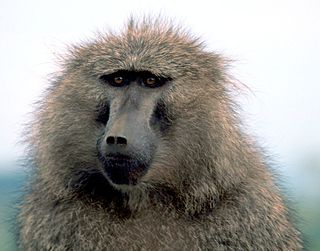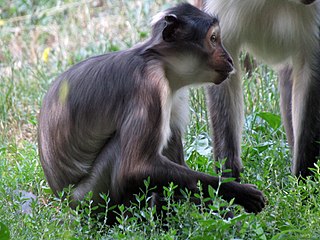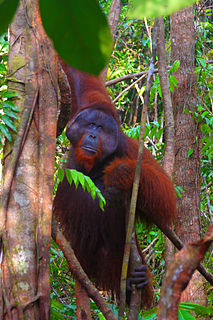Related Research Articles

The chimpanzee, also known simply as chimp, is a species of great ape native to the forest and savannah of tropical Africa. It has four confirmed subspecies and a fifth proposed subspecies. The chimpanzee and the closely related bonobo are classified in the genus Pan. Evidence from fossils and DNA sequencing shows that Pan is a sister taxon to the human lineage and is humans' closest living relative. The chimpanzee is covered in coarse black hair, but has a bare face, fingers, toes, palms of the hands, and soles of the feet. It is larger and more robust than the bonobo, weighing 40–70 kg (88–154 lb) for males and 27–50 kg (60–110 lb) for females and standing 120 to 150 cm.

Gorillas are herbivorous, predominantly ground-dwelling great apes that inhabit the tropical forests of equatorial Africa. The genus Gorilla is divided into two species: the eastern gorilla and the western gorilla, and either four or five subspecies. The DNA of gorillas is highly similar to that of humans, from 95 to 99% depending on what is included, and they are the next closest living relatives to humans after chimpanzees and bonobos.

Orangutans are great apes native to the rainforests of Indonesia and Malaysia. They are now found only in parts of Borneo and Sumatra, but during the Pleistocene they ranged throughout Southeast Asia and South China. Classified in the genus Pongo, orangutans were originally considered to be one species. From 1996, they were divided into two species: the Bornean orangutan and the Sumatran orangutan. A third species, the Tapanuli orangutan, was identified definitively in 2017. The orangutans are the only surviving species of the subfamily Ponginae, which diverged genetically from the other hominids between 19.3 and 15.7 million years ago.

A primate is a eutherian mammal constituting the taxonomic order Primates. Primates are sister to Dermoptera, together forming the Primatomorpha. It consists of the otherwise extinct plesiadapiformes and its descendents, the lemurs, the haplorhini. With the crown-primates (euprimates) cladistically included in the plesiadapiformes, it becomes a junior synonym for primates, then sometimes referred to as pan-primates.

The bonobo is an endangered great ape. It is one of the two species making up the genus Pan, the other being the common chimpanzee. While bonobos are now recognized as a distinct species in their own right, they were initially thought to be a subspecies of chimpanzee due to the physical similarities between the two species. Taxonomically, the members of the chimpanzee/bonobo subtribe Panina are collectively termed panins.

Black-and-white colobuses are Old World monkeys of the genus Colobus, native to Africa. They are closely related to the red colobus monkeys of genus Piliocolobus. There are five species of this monkey, and at least eight subspecies. They are generally found in high-density forests where they forage on leaves, flowers and fruit. Social groups of colobus are diverse, varying from group to group. Resident-egalitarian and allomothering relationships have been observed among the female population. Complex behaviours have also been observed in this species, including greeting rituals and varying group sleeping patterns. Colobi play a significant role in seed dispersal.

Primatology is the scientific study of primates. It is a diverse discipline at the boundary between mammalogy and anthropology, and researchers can be found in academic departments of anatomy, anthropology, biology, medicine, psychology, veterinary sciences and zoology, as well as in animal sanctuaries, biomedical research facilities, museums and zoos. Primatologists study both living and extinct primates in their natural habitats and in laboratories by conducting field studies and experiments in order to understand aspects of their evolution and behavior.

Apes are a clade of Old World simians native to Africa and Southeast Asia, the other being its sister group Cercopithecidae, together forming the catarrhine clade. The New World monkeys diverged earlier from the old world stock of monkeys, by settling across the Atlantic ocean. They are distinguished from other primates by a wider degree of freedom of motion at the shoulder joint as evolved by the influence of brachiation. Apes do not have tails, apparently due to a mutation of the TXBT gene. In traditional and non-scientific use, the term "ape" can include tailless primates taxonomically considered Cercopithecidae, and is thus not equivalent to the scientific taxon Hominoidea. There are two extant branches of the superfamily Hominoidea: the gibbons, or lesser apes; and the hominids, or great apes.

The mirror test—sometimes called the mark test, mirror self-recognition (MSR) test, red spot technique, or rouge test—is a behavioral technique developed in 1970 by American psychologist Gordon Gallup Jr. as an attempt to determine whether an animal possesses the ability of visual self-recognition. The MSR test is the traditional method for attempting to measure physiological and cognitive self-awareness. However, agreement has been reached that animals can be self-aware in ways not measured by the mirror test, such as distinguishing between their own and others' songs and scents.

The sooty mangabey is an Old World monkey found in forests from Senegal in a margin along the coast down to the Ivory Coast.

The Sumatran orangutan is one of the three species of orangutans. Critically Endangered, and found only in the north of the Indonesian island of Sumatra, it is rarer than the Bornean orangutan but more common than the recently identified Tapanuli orangutan, also found in Sumatra. Its common name is based on two separate local words, "orang" and "hutan" ("forest"), derived from Malay, and translates as 'person of the forest'.
A facultative biped is an animal that is capable of walking or running on two legs (bipedal), as a response to exceptional circumstances (facultative), while normally walking or running on four limbs or more. In contrast, obligate bipedalism is where walking or running on two legs is the primary method of locomotion. Facultative bipedalism has been observed in several families of lizards and multiple species of primates, including sifakas, capuchin monkeys, baboons, gibbons, gorillas, bonobos and chimpanzees. Different facultatively bipedal species employ different types of bipedalism corresponding to the varying reasons they have for engaging in facultative bipedalism. In primates, bipedalism is often associated with food gathering and transport. In lizards, it has been debated whether bipedal locomotion is an advantage for speed and energy conservation or whether it is governed solely by the mechanics of the acceleration and lizard's center of mass. Facultative bipedalism is often divided into high-speed (lizards) and low-speed (gibbons), but some species cannot be easily categorized into one of these two. Facultative bipedalism has also been observed in cockroaches and some desert rodents.
Ai is a female western chimpanzee, currently living at the Primate Research Institute of Kyoto University. She is the first subject of the Ai project, a research program started in 1978 by Kiyoko Murofushi and Tetsuro Matsuzawa which is aimed at understanding chimpanzee cognition through computer interface experiments.

The Bornean orangutan is a species of orangutan endemic to the island of Borneo. Together with the Sumatran orangutan and Tapanuli orangutan, it belongs to the only genus of great apes native to Asia. Like the other great apes, orangutans are highly intelligent, displaying tool use and distinct cultural patterns in the wild. Orangutans share approximately 97% of their DNA with humans.

The Hominidae, whose members are known as the great apes or hominids, are a taxonomic family of primates that includes eight extant species in four genera: Pongo ; Gorilla ; Pan ; and Homo, of which only modern humans remain.
Primate cognition is the study of the intellectual and behavioral skills of non-human primates, particularly in the fields of psychology, behavioral biology, primatology, and anthropology.

Nest-building in primates refers to the behaviour of building nests by extant strepsirrhines and hominid apes. Strepsirrhines build nests for both sleeping and raising families. Hominid apes build nests for sleeping at night, and in some species, for sleeping during the day. Nest-building by hominid apes is learned by infants watching the mother and others in the group, and is considered tool use rather than animal architecture. Old World monkeys and New World monkeys do not nest. It has been speculated that a major evolutionary advance in the cognitive abilities of hominoids may first have occurred due to the development of nest-building behaviour and that the transition from nest-building to ground-sleeping led to "modifications in the quality and quantity of hominid sleep, which in turn may have enhanced waking survival skills through priming, promoted creativity and innovation, and aided the consolidation of procedural memories".

Sexual swellings are enlarged areas of genital and perineal skin occurring in some female primates that vary in size over the course of the menstrual cycle. Thought to be an honest signal of fertility, male primates are attracted to these swellings; preferring, and competing for, females with the largest swellings.

Personality in animals has been investigated across a variety of different scientific fields including agricultural science, animal behaviour, anthropology, psychology, veterinary medicine, and zoology. Thus, the definition for animal personality may vary according to the context and scope of study. However, there is recent consensus in the literature for a broad definition that describes animal personality as individual differences in behaviour that are consistent across time and ecological context. Here, consistency refers to the repeatability of behavioural differences between individuals and not a trait that presents itself the same way in varying environments.
Aurelio José Figueredo is an American evolutionary psychologist. He is a Professor of Psychology, Family Studies and Human Development at the University of Arizona, where he is also the director of the Ethology and Evolutionary Psychology Laboratory. He is also a member of the interdisciplinary Center for Insect Science at the University of Arizona. His major areas of research interest are the evolutionary psychology and behavioral development of life history strategy, cognition, sex, and violence in human and nonhuman animals, and the quantitative ethology and social development of insects, birds, and primates. He is known for his research on personality, such as a 1997 study in which he and James E. King developed the Chimpanzee Personality Questionnaire to measure the Big Five personality traits in chimpanzees.
References
- ↑ King, James E.; Figueredo, Aurelio José (June 1997). "The Five-Factor Model plus Dominance in Chimpanzee Personality". Journal of Research in Personality. 31 (2): 257–271. doi:10.1006/jrpe.1997.2179.
- ↑ Goldberg, Lewis R. (1990). "An alternative "description of personality": The Big-Five factor structure" (PDF). Journal of Personality and Social Psychology. 59 (6): 1216–1229. doi:10.1037/0022-3514.59.6.1216. PMID 2283588 . Retrieved 2 March 2019.